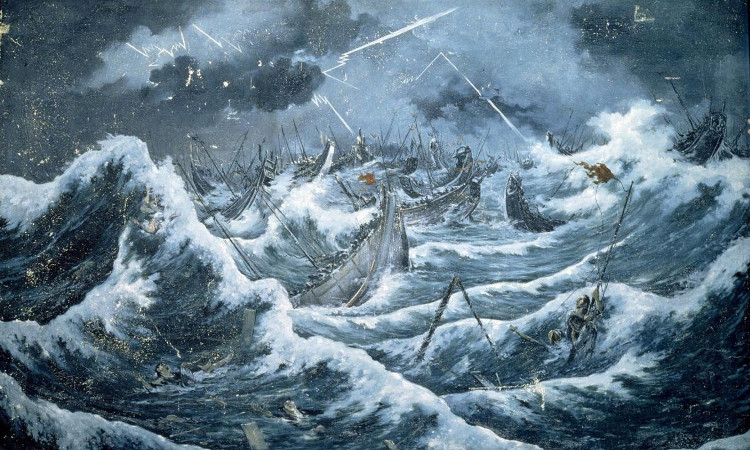'Typhoon' defeated the invasion of the Mongolian empire
A sudden hurricane and storm surged to help the Japanese escape the danger situation before the invasion of the Mongols.
According to Guardian, August 1281, Kublai Khan, the great reign of the Mongolian empire, sent Japanese invaders. But similar to the previous invasion in 1274, the Mongols once again failed due to weather factors.
The strong invasion army with more than 4,000 warships and 140,000 soldiers, comes from South Korea and China. The Japanese were not inferior in number but were poorer because the Mongols carried new weapons such as exploding arrows and grenades.

The violent storm caused the Mongol invaders to defeat the Japanese.(Artwork: Issho Yada).
However, the Japanese forces still tightened their defenses, making the Mongol soldiers unable to capture Kyushu. While the two sides were in a tug of war, a violent storm rose.
Do not want to be trapped in enemy territory, Mongolian invaders retreat to the ship and try to move in storms. Many warships collided with each other or crashed into a cliff, causing most soldiers to drown.
The surviving troops were swept onto the coast by the waves and died under the Japanese sword. Only a few hundred warships returned safely to Mongolia, marking the complete invasion.
In Japan, the hurricane was seen as a sign of gods' support and was named "wind god" or Kamikaze in Japanese.
Strong storms rarely occur in Kyushu. However, the researchers looked at the lake bottom sediment in the area to detect traces of severe flooding in the 13th century. Besides, analysis of the Mongol ship's warship indicates quality. poor production and not strong enough to move in storms.
- The reason Mongolia became the greatest empire in history
- Barriers to Mongolian horse horses flooded into Europe
- The most powerful Empire ever defeated the Roman Empire and ended after 'bullying' Russia
- Simple invention made the Mongolian empire
- Tiny animals banish the Mongolian army, save Europe from destruction?
- Roman army defeated 8,000km lost to China?
- Fraternity is similar to the collapse of the Inca empire
- The mystery behind the success of Genghis Khan
- The mysterious screen about the burial place of Genghis Khan
- Weather - The element of surprise decides the defeat of battle
- Learn 4 Iraq's mighty empire
- Shocking revelations about the mighty warrior of Genghis Khan
 Biography of hero Vu A Dinh
Biography of hero Vu A Dinh History of hematology
History of hematology Who is Mr. Tam Da 'Phuc-Loc-Tho' and what does it mean?
Who is Mr. Tam Da 'Phuc-Loc-Tho' and what does it mean? Unbelievable facts about the history of the oil and gas industry: Gasoline used to be cheaper than water, so abundant that it had to be dumped into the river...
Unbelievable facts about the history of the oil and gas industry: Gasoline used to be cheaper than water, so abundant that it had to be dumped into the river... The special sitting posture of Japanese people helps prolong life and prevent diseases.
The special sitting posture of Japanese people helps prolong life and prevent diseases.  Why are Japanese people no longer interested in rice and gradually switching to bread?
Why are Japanese people no longer interested in rice and gradually switching to bread?  Why are Japanese people less obese?
Why are Japanese people less obese?  Why are trains in Japan always on time?
Why are trains in Japan always on time?  Poor people in Nepal changed their lives by providing Japanese shrubs to make paper for printing money
Poor people in Nepal changed their lives by providing Japanese shrubs to make paper for printing money  History of famous Japanese desserts
History of famous Japanese desserts 